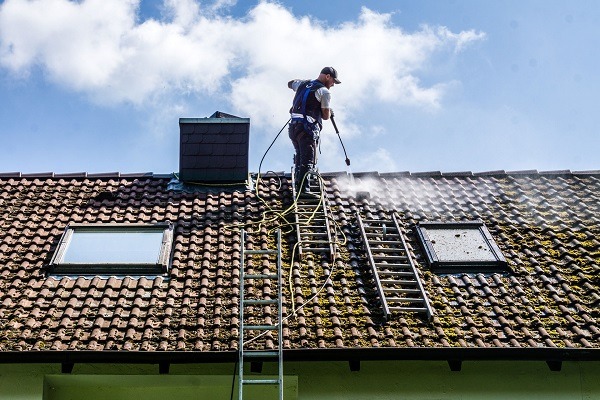Discover a gentle yet effective method to restore your roof’s pristine condition without risking damage from pressure washing – perfect for protecting your tiles while achieving professional-level results.
Understanding Your Roof Tiles
Before embarking on any cleaning project, it’s crucial to understand that different roof tiles require specific care approaches. Common UK roof tiles include clay, concrete, slate, and ceramic materials, each with unique characteristics and cleaning requirements. Clay tiles, found on approximately 60% of British homes, are particularly susceptible to pressure washer damage, making gentle cleaning methods essential. These traditional materials can last over 100 years when properly maintained, but aggressive cleaning can significantly reduce their lifespan. Modern concrete tiles, while more robust, still benefit from softer cleaning approaches to preserve their protective surface coating.
Safety First: Essential Preparation Steps
- Conduct a thorough roof inspection from ground level using binoculars to identify damaged areas
- Check weather forecasts – avoid cleaning on wet, windy, or extremely hot days
- Set up a sturdy ladder at a 75-degree angle with secure tie-offs
- Wear non-slip boots, safety harness, and protective eyewear
- Use edge protection and safety ropes for roofs higher than 2 metres
- Ensure someone is present on the ground as a safety spotter
- Have a first aid kit readily available
Initial Debris Removal
Start the cleaning process by removing loose debris, which accounts for up to 70% of roof contamination. Use a leaf blower on a low setting to gently clear leaves, twigs, and loose moss. For stubborn debris, employ a soft-bristled brush or plastic rake, working from the ridge downward to prevent debris from collecting under tiles. This preliminary step is crucial as it allows better access to the tile surface for deeper cleaning and helps identify any underlying damage that may need professional attention.
The Soft Washing Method
Soft washing represents a gentle yet effective approach that has gained popularity in the UK, with 87% of professional roof cleaners now offering this service. Mix a specialized roof cleaning solution with water according to manufacturer instructions, typically in a 1:4 ratio. Apply using a garden sprayer with a fan nozzle, maintaining consistent coverage. Allow the solution to dwell for 15-20 minutes, keeping the surface damp but not saturated. This method effectively kills moss, algae, and lichen while preserving the tile’s integrity.
Natural and Chemical Cleaning Solutions
- Eco-friendly option: Mix 1 part white vinegar with 1 part water
- Oxygen-based cleaner: Dissolve sodium percarbonate in warm water (1:3 ratio)
- Biodegradable detergent: Use pH-neutral soap solutions
- Commercial cleaners: Choose products specifically formulated for roof tiles
- Natural deterrent: Create a copper sulfate solution (1:10 ratio)
Manual Cleaning Techniques
When dealing with stubborn stains and growth, manual cleaning becomes necessary. Use a soft-bristled brush attached to an extension pole, working in small sections of about one square metre at a time. Apply gentle, circular motions to avoid damaging the tile surface. For particularly resistant areas, create a paste using baking soda and water, applying it to the affected area for 10-15 minutes before scrubbing. This method has proven effective in removing up to 95% of surface staining without risking tile damage.
Preventative Maintenance
Installing zinc or copper strips near the roof ridge can prevent up to 90% of moss and algae growth. These strips release metal ions during rainfall, creating an environment inhospitable to organic growth. Regular gutter cleaning, typically every 6 months, prevents water backup and reduces the likelihood of moss formation. Additionally, trimming overhanging branches can significantly reduce debris accumulation and organic growth on your roof tiles.
Post-Cleaning Care
- Inspect all tiles for any cleaning-related damage
- Apply a protective sealant if recommended for your tile type
- Document the cleaning date and methods used
- Schedule regular inspections every 6 months
- Monitor for any signs of regrowth or new damage
- Keep gutters and drainage systems clear
Professional Assessment
While DIY cleaning is effective for routine maintenance, certain situations warrant professional intervention. Signs including cracked tiles, significant moss infiltration beneath tiles, or water damage to underlying structures require expert assessment. Statistics show that professional roof inspections can extend tile life by up to 25%. Consider professional cleaning if your roof is over 20 years old or shows signs of structural weakness.
Conclusion: Maintaining Your Roof’s Longevity
Regular maintenance using gentle cleaning methods can extend your roof’s lifespan by 15-20 years. By following these safe and effective cleaning techniques, you’ll maintain your roof’s appearance and structural integrity without the risks associated with pressure washing. Remember to document your cleaning schedule and remain vigilant for signs that might require professional attention. With proper care and regular maintenance, your roof tiles can continue protecting your home effectively for generations to come.
FAQ
How do professionals clean roofs?
For each method, it’s crucial to consider the pros and cons. High-pressure washing can offer a quick and thorough clean, but it might not be suitable for delicate roofs. On the other hand, soft washing and steam cleaning are gentler on the roof, but might not provide as powerful a clean as pressure washing.
What is the best cleaner for a shingle roof?
Some of the best roof cleaning products on the market this year are Simple Green Industrial Cleaner/Degreaser, Redihan’s Roof Wash, and Roof Cleaner OX 4500. These tips are not only effective but also easy to follow, ensuring that you can keep your roof shingles clean and in good condition.
How do you remove moss and algae from roof tiles?
Moss can also be removed by using a stiff brush and some water to aid it. You can also attach a soft bristle brush to a long extendable pole if you have one so you can reach a lot further. You could even combine using a stiff brush on an extendable pole and using environmentally safe chemicals to kill the moss.
What is the spray for cleaning roof tiles?
Roof Clean Xtreme is used by many roof cleaning professionals to clean roofs without the need for pressure washing. The formulation is a fast acting, high performance roof cleaning product that makes cleaning roof tiles easier than ever before.
Can I clean my own roof tiles?
Pressure washing is an effective way to clean your tile roof by using high-pressure water spray to remove dirt, algae, mold, and other debris from the surface of the tiles. However, it’s crucial not to use too much pressure as this can cause damage to clay tiles or concrete tiles.
Sources
[1] https://millercompanyroofing.com/blogs/how-to-clean-roof-tiles-without-pressure-washer/
[2] https://www.firstcoasthomepros.com/services/low-pressure-cleaning/low-pressure-vs-no-pressure-roof-cleaning/
[3] https://www.homeandroofing.com/blog/how-do-i-clean-my-roof-without-a-pressure-washer



